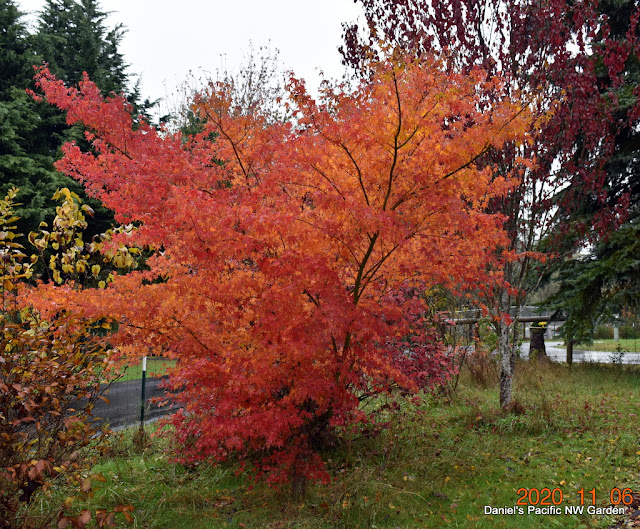 |
| Nikita's Gift Hybrid Persimmon. 11.3.15 |
Today I stopped by the One Green World nursery outlet in Portland. Fall is a good time to plant many types of trees. I found two fruit varieties to try:
American persimmon "Prairie Star" (
Diospyros virginiana) and Korean bush cherry (
Prunus japonica). More on the bush cherry later.
Back at Battleground, the persimmons have nice fall color. The best is Nikita's Gift - a hybrid between
Diospyros virginiana and Asian persimmon,
Diosyyros kaki. The little Prairie Star also has nice color.
Asian Persimmon "Saijo" had a tough summer, too much heat. The leaves curled, but did not fall off. They have nice color now, but it's hard to see due to the curled leaves. Maybe next year it will do better.
The other American persimmon, Yates, doesn't look like much this year as far as leaf color goes.
 |
| Prairie Star American Persimmon. 11.3.15 |
 |
| Saijo Asian Persimmon. 11.3.15 |
Other fruit trees / plants with nice fall color were the NC1 Pawpaw and the genetic dwarf peach seedling. The peach seeedling has fuzzy buds. Those might indicate flower buds for next Spring. It is about 3 years post germination.
It was interesting looking at the persimmons at One Green World. They had several Nikita's Gift persimmons with big fruits on the 1 foot tall plants. I asked the clerk how they accomplish that. He didn't know. They also had a kaki persimmon from Xian, which had little green fruits. That did not seem promising to me, November and no where near ripe.
Mine may have received too much nitrogen this year. It is a gamble. Too little nitrogen, growth is puny. Too much, and fruits don't set or fall off. I will probably fertilize the two little American persimmons prior to Spring, but not the Asian and hybrid, which are both over 6 foot tall, so I don't need growth on those so much as wanting to taste the fruits.
 |
| NC1 Pawpaw. 11.3.15 |
 |
| Nikita's Gift Persimmons at One Green World Nursery. 11.3.15 |
American Persimmons are not yet developed as commercial fruits. The challenges are, they tend to be small, too soft to ship, and have a bad reputation because anyone who has tried an unripe one never wants to try again. When ripe, they are very soft, and lose their astringency. They also have the challenge that, in their wild state, male and female trees are separate, and the females require pollination to form fruits. Many varieties of Asian persimmons lost the need for a male to pollinate them (parthenocarpic), and those fruits are seedless. Saijo does not need a pollinator, and apparently neither does Nikita's Gift.
Yates / Juhl is parthenocarpic.
James Claypool was an amateur who attempted to breed persimmons as an ideal fruit for home gardener or orchard. He trialed thousands of hybrids, starting with varieties from earlier, mainly amateur, developments and improvements over wild persimmons. When Claypool developed an illness and could no longer work on his persimmons, the Indiana Nut Growers Association took over.
 |
| Seedling Genetic Dwarf Peach. 11.3.15 |
 |
| Yates (Juhl) American Persimmon. 11.3.15 |




















